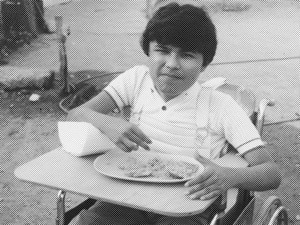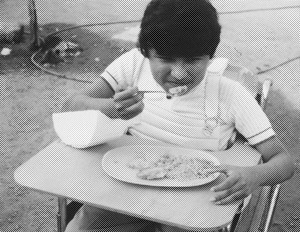Hesperian Health Guides
Homemade Equipment to Help Eating
| This boy, whose arms and hands are paralyzed, lifts his spoon by raising and lowering his shoulder. His forearm is on the table edge, so that when he lowers his elbow, his hand lifts. |  |
A non-slip mat under the plate can be made from strips of tire tube woven over a stiff wire frame. | |
| The spoon slips into a leather or rubber (tire tube) hand band. (Also, see "Eating and Drinking Aids".) |  Velcro (or buckle) |
 |
The plate can be made from a small plastic bucket. |
| To prevent slipping, you can glue (with a waterproof glue) strips of tire tube on the bottom. | |||
| Tortilla or chapati holder |
| tortilla |
 |
| From UPKARAN Manual |
| Spoon handles for easy gripping | |||
 |
 |
 |
|
| rubber tube | rubber ball | strip of tire tube (wrapped) | |
| piece of wood | |||
 |
 | ||
| old tool handle | cut off spoon | bend the handle to fit the child’s grip | |
Swing-a-sling eating aid
| This eating aid lets a child with very little strength in her arm feed herself. However, it must pivot smoothly but firmly at 3 points. It will take a skillful and imaginative craftsperson to make it. |  |
The spoon holder can also be adapted to hold a pen, brush, and other things. |
Arm rocker—for a child whose arm is too weak to lift
| Carve it out of wood — or glue together layers of Styrofoam (stiff foam plastic) or cardboard. |  | ||
| Or make it from the bottom of an old plastic (or metal) bucket. |  |
Straps may or may not be needed. | |
 |
 | ||
| Heat the plastic along the lines with a hot strip of metal. | And bend it like this. | ||
 |
 |
| A boy with muscular dystrophy, whose arm is too weak to lift it to his mouth, eats with the aid of an arm rocker. This arm rocker, cut out of Styrofoam, took about 5 minutes to make. | |
Feeding aids for a child with no hand use
| Put a rubber band or clip on the spoon handle to keep spoon from slipping in clothespin. | |
 clothespin or carved wood
nail
hole through clothespin slightly bigger than nail
small nails to limit how far clothespin can rotate
post
block of wood |
 |
| hole that can be filled with lead to make the base heavy (Heat lead in an old pan or can and pour it into the hole.) strips of tire tube to prevent slipping |
| Pick up food holding spoon in mouth. | Slip spoon into clothespin. | With the lips, turn clothespin so that spoon enters mouth. |
 |
 |
 |
Note: If other children laugh at the child’s awkwardness, let him practice alone until he gains some skill.
| Children with no use of their arms can feed themselves by lowering their mouths to their food. It helps if the plate can be lifted nearer to the face. A pot like this helps to stabilize the plate. If the plate has a rounded bottom, the child can tip it bit by bit as it is emptied. |  |
A rack allows the child to drink from a cup that he can tip with his mouth. Or simply use a straw. |
Use your imagination to think of many other ways to help a child with disabilities eat and do other things for herself.
This page was updated:04 Apr 2024





